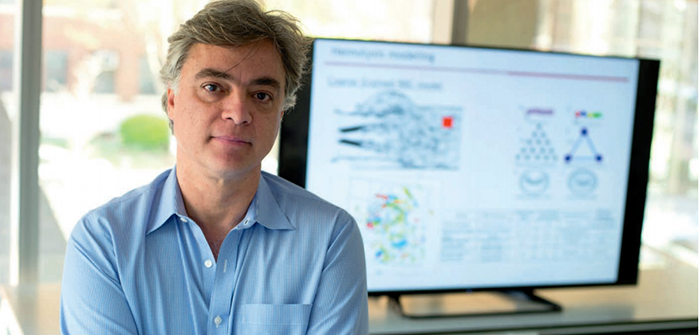Dr. Elias Balaras conducts research in multi-physics simulations in a variety of fluid mechanics problems. Stated another way, he uses powerful super-computers and advanced math models to tackle challenging fluid flow problems in biology and engineering.
Fluid mechanics studies how liquids and gases behave in motion under the action of internal and external forces—think of air flows around an airplane wing, or water flows around a ship’s hull, or even how blood flows through veins and arteries.
“Multi-physics simulations are at the boundaries of scientific computing, numerical analysis, and whatever discipline you’re looking at—in my case, fluid mechanics,” says Dr. Balaras. “You have to take advantage of advancements in all of these areas to be able to do state-of-the-art research.”
And that is what he and his research team are doing here at SEAS. The project he is most proud of is his work to model and optimize the design of an implantable graft used in aortic valve by-pass surgery to improve the outcomes for elderly patients with aortic valve disease (AVD). AVD is caused by calcification that decreases the aortic valve orifice. It is a dangerous condition that reduces life expectancy and quality of life for patients.
Many patients with AVD can be treated successfully through aortic valve replacement surgery, but a large group of patients who are not healthy enough to undergo open heart surgery are typically left untreated. These patients can now benefit from a much less invasive procedure that does not require stopping the heart. This alternative procedure uses a small tube attached to the apex of the heart on one end and the descending aorta on the other, allowing some of the blood to flow through the heart’s natural valve and some to flow through the tube so the heart does not have to work so hard.
The idea for the aortic valve bypass procedure is not new, but technical issues, including a good understanding of the procedure’s impact on the local circulation, were an obstacle in its widespread use. Working with collaborator Dr. James Gammie, chief of the Division of Cardiac Surgery at the University of Maryland’s School of Medicine, Dr. Balaras created computational models of a realistic heart and performed the operation virtually, studying how the circulation was impacted by the graft. They then optimized the geometry of the graft using the computational model.
“The optimized graft is routinely used in aortic valve bypass surgeries by Dr. Gammie’s team,” states Dr. Balaras. He continues, “I’m trained as an applied mathematician, but when I find something challenging I’ll try to push the boundaries to find something that will have an impact on people’s lives, like this.”


